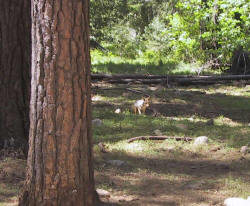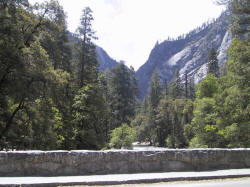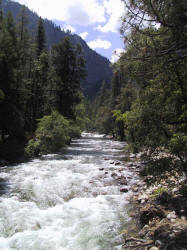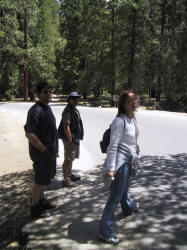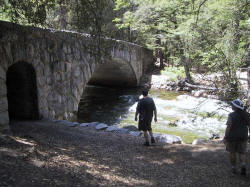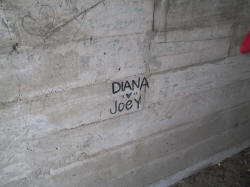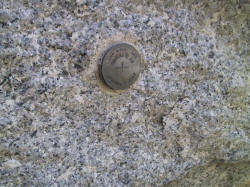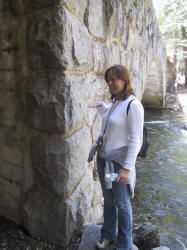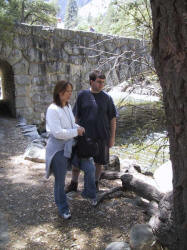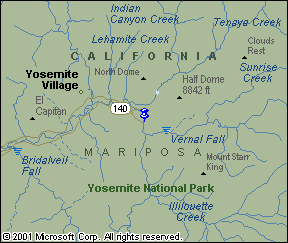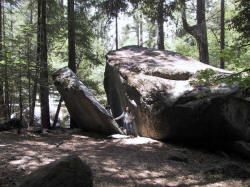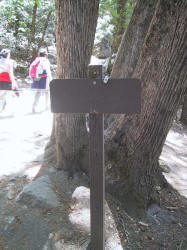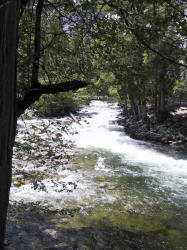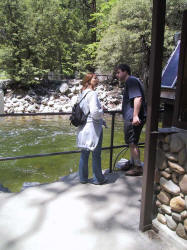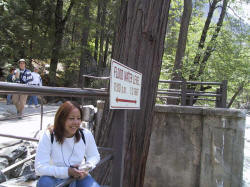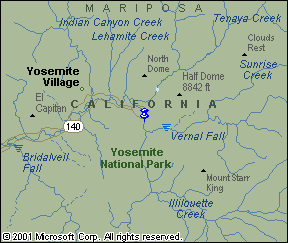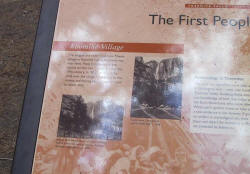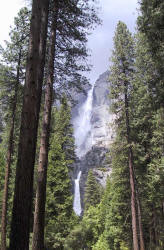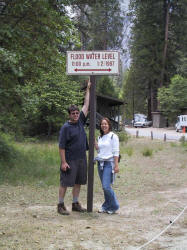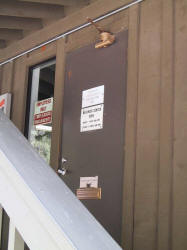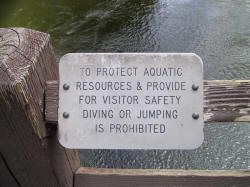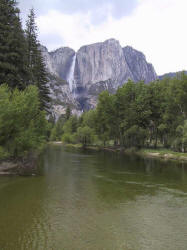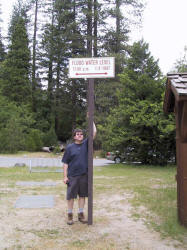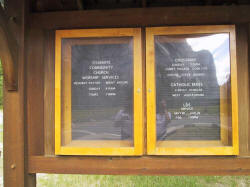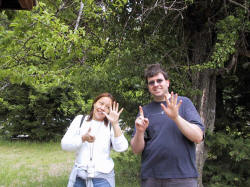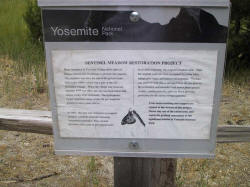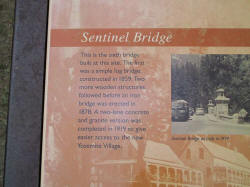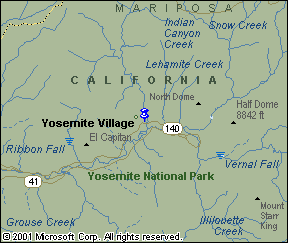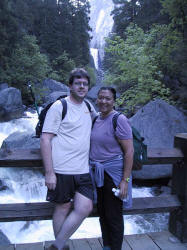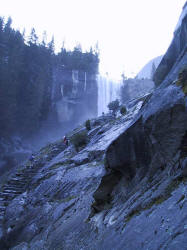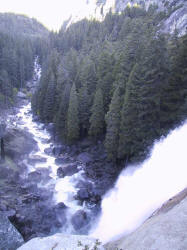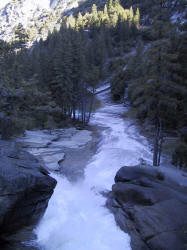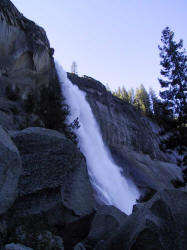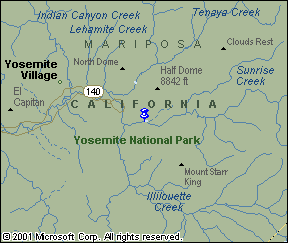Yosemite
May 21, 2004
This was such an amazing weekend! We arrived in Yosemite Thursday night with our friend, Linda. We were all staying at the Curry Village. Friday morning, Jimmy, Linda and I had breakfast with Eric, Lauree, Jim, Bambi, Dave, Nancy, Terry, Amy at the Curry Dining Pavilion. Around noon, everyone split up to do their own adventures. Eric stayed in the village to wait for everyone to come in. Dave Retz went out exploring on his own. Terry and Amy went up to Glacier Point. Lauree, Jim, Bambi, Dave, Linda, Jimmy and I all headed to the Happy Isle trailhead. For our first geocache today, all 7 of us helped to find it: A Happy Place. We introduced Bambi and Dave to geocaching. Lauree, Jim and Linda have heard about our previous adventures so they were curious about what it entails.
Since Yosemite is a National Park, there are no physical caches allowed in the park, so all of the geocaches we did this weekend are called virtual geocaches, which means you need to find the answers to something rather than a container.
The text in the smaller font is information from the geocache owner.
|
A Happy Place link to the geocaching website This is a beautiful geocache location with a fun challenge. I like things that are happy. This is a happy place despite some recent local disasters. The structure you are standing on is still in good shape despite a nearby massive rockfall and windblast in the Happy Isles area that damaged the nearby Happy Isles Gauging Station Bridge in July 1996. Then a major flood in January 1997 caused extensive damage to human-made structures along the main stem of the Merced River, including that same Happy Isles Gauging Station Bridge. That bridge was removed for safety reasons and the Gauging Station will be relocated in the future. Huge rocks were embedded in the trunks of hundreds-year-old trees, as if the trees were mere clay. Giant trunk carcasses were strewn about as if they were straw. But this structure you are standing on survived it all unscathed. Enjoy the view and enjoy the cache hunt.
TO GET CREDIT
FOR THIS VIRTUAL CACHE, EMAIL TO ME ANSWERS TO THE FOLLOWING QUESTIONS: After you email me your answers, go ahead and log your find. Please do not enter the answers in the logs. Please remove any trash you find in the area.
Linda, Jimmy and I started hiking to the Happy Isle trailhead from Curry Village and coincidentally ran into Lauree, Jim, Bambi and Dave when we arrived. When we met up with them, we also saw a coyote! He was completely un-phased by us and just strolled along as if our presence was normal. Since they were with us, they all decided to stay and help us find our first geocache of the day. We also ran into 2 other cachers looking for this
|
|
|
Yosemite Valley High Water – The 100 Year Flood link to the geocaching website Not too long ago, Yosemite Valley experienced a remarkable wintertime flood resulting from unseasonable warm rains on top of a substantial early snow pack. This easy 2-mile loop introduces visitors to the heart of the valley and seven waypoints that reflect some of Yosemite’s most scenic wonders. The 100 Year Flood was a once in a lifetime experience. Team Gecko happened to be visiting immediately prior to the flood during their nearly annual winter visit in the valley. The tropical rains began a day or so before our departure. The flood resulted from 10 inches of rain over a 6-day period that melted a substantial portion of the snow pack up to the 11,000 foot elevation level. Some of the resulting damage and changes to the valley and Merced River canyon were extraordinary – at least in human terms. Of course, Yosemite Valley has witnessed many and more dramatic natural events over the millions of years of its formation and sculpting. To complete this virtual cache, you will walk or bike or ski or snowshoe around a well-marked path in the heart of the valley. Parking is available very close to the posted coordinates for Waypoint 1. You may also ride one of the free Yosemite shuttle buses from any of the regular pickup points to this starting location. At each waypoint, you will find clues that allow you to determine coordinates for the next waypoint. To confirm successful completion of the course, please email your responses to the questions asked about each stop. Special note: GPS reception in the valley can be variable at times, especially in forested areas and on the south side. Many of these reference coordinates are rounded to nearest .005. The respective waypoints should be reasonably obvious once you are this close to their true positions.
Waypoint 1: N37° 44.790, W119° 35.775
Waypoint 2: N37° 44.45a, W119° 36.a00
Waypoint 3: N37° 44.c10, W119° 36.000
Waypoint 4: N37° 44.485, W119° 35.e10 where e = d - c
Waypoint 5: N37° 44.495, W119° 35.e20 where e is the same as for
Waypoint 4
Waypoint 6: N37° 44.gf2, W119° 35.402
Waypoint 7: N37° 44.d52, W119° 35.d43
This
completes the tour of Team Gecko’s High Water virtual cache. We hope
you enjoyed navigating the course. Have a pleasant and enriching
time during your visit to Yosemite National Park. This was the most complex geocache we've done so far. Having all of the different way points, and having to solve the puzzle to get certain waypoint numbers was a lot of fun! We luckily got off the correct bus stop and headed towards the first coordinates. We easily found the answers, and while we were there headed up to lower Yosemite Falls. After that, we headed to waypoint 2-7. The trail that this cache led us on was great because there were tons of amazing views along the way. Plus we were shocked at how high the water level was on January 2, 1997. During breakfast that morning, Nancy was telling us about stories that employees at the Awahnee told her. How there was so much water coming off the granite cliffs that it looked like reverse bathbub flowing into the valley. Everywhere you looked, the granite walls were pouring water, everywhere was a waterfall.
|
May 22, 2004
Today was the day of the "Big" hike. About 50 of our group were going on the trail to Half Dome. Many would go all the way to the top, some would go at their own pace and go up as far as they wanted. Most of us left Curry Village at 5:30 in the morning and walked to Happy Isles. Around 6:15, Jimmy and I headed up Mist Trail with Linda, Vanessah and Stan. We all climbed it at our own pace. It wasn't drenchingly wet, but definitely wet enough to warrant a poncho, at least in mine and Jimmy's opinion. Yesterday, we knew that this cache was up here, but since it was so early and we were concentrating on the hike, we forgot about it till we got home. Luckily we knew the answers so we could log our find.
|
N 37° 43.636 W 119° 32.599 link to the geocaching website This virtual cache is located at the top of the Vernal Falls Mist trail. Finding the virtual cache is relatively easy, getting there is a little harder, and very wet! Take a nice hike up the Vernal Falls Mist trail to find this virtual cache and a nice view from the top of the Vernal Fall. The trailhead we started at was about 1 mile south east Curry Village, but there are numerous other ways to get to this cache. To log this cache, please identify the two bodies of water you are prohibited from swimming in. Have fun, and watch your footing when the water is running! Don't worry about emailing me to confirm the bodies of water, I trust that geocachers are honorable people. However, feel free to email me with pictures or comments about the hike. Enjoy!
|
